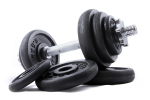- FreeTrainers.com Forums
- General Fitness & Exercise
- Muscile Sorness....
Group: General Fitness & Exercise
Created: 2011/12/31,
Members: 379,
Messages: 54577
Various general exercise related discussions. Find out what it takes to reach your fitness goals through daily effective exercise. With so many options we try to find out what works best.
Join group
Muscile Sorness....

SeanyBoy
Posts:
95
Joined: 2001/08/16  |
2001/08/18, 04:02 AM
need to ask...some times when i work out my muscles get sore, but some times it doest... i was wondering why... is it because my body got used to weights or what? when i work out i work out very very intense, i work with very heavy weights 4-8 reps max... 3 sets.. but my muscles still doest get that sore .... should i work out even more intense? what am i doin wrong.. any comments might help.. thanks for your time SeanyBoy |
|
| |

Arnold
Posts:
1,112
Joined: 2000/11/27  |
2001/08/19, 06:53 PM
Hey Sean,YES. Yes your muscles should be sore after each workout.. even if it is just a bit. This pain / soreness tells you that you have torn the muscle fibres - and they will repair and adapt - therefore become stronger and larger. Maybe you need to concentrate on range of motion. It is very key to remember to get a FULL stretch and FULL contraction of the muscles at work - every rep of every set. Good Luck. .o0 Arnold 0o. |

SeanyBoy
Posts:
95
Joined: 2001/08/16  |
2001/08/20, 01:59 AM
Thanks alot Arnold.. your comments are always help ful. Cheers Seanyboy |

the_w8lifter
Posts:
138
Joined: 2001/08/03  |
2001/08/23, 08:27 AM
I disagree with Arnold about muscle soreness. I don't believe that the soreness reflects the amount of microtrauma sustained by the muscle. The soreness is caused by the build up of lactic acid. This is produce during and after a workout. A number of factors can reduce this effect including the consumption of potassium (i.e. bananas). In my book, soreness or lack there of is not a reflection of the effectiveness of your workout. |

Arnold
Posts:
1,112
Joined: 2000/11/27  |
2001/08/23, 01:28 PM
I disagree with the_w8lifter.Muscle soreness which ocurs aprox 8-14 hours following a workout does reflect the amount of microtrauma sustained by the specific muscle isolated. Lactic acid is responsible for the 'burning' sensation during the final phase of your set.. due to the lowered presence of oxygen. The consumption of potassium simply lowers the chances of 'muscle cramps' to be less technical - during your muscle recovery phase. .o0 Arnold 0o. |

the_w8lifter
Posts:
138
Joined: 2001/08/03  |
2001/08/24, 10:20 AM
Let's clarify. Arnold and I are in complete agreement, just talking about different stages of the workout process. Sorry for the confusion. I still do not believe that muscle soreness (either during workout or after) is a clear measurement for performance. I believe the following article summarizes ALL the issues and supports this opinion.Delayed-Onset Muscle Soreness: Work Out Now, Pay Later? CAPT Michael Ross, MSEd, PT, OCS THE PHYSICIAN AND SPORTSMEDICINE - VOL - NO. - 1999 ------------------------------------------------------------ Even though the benefits of regular exercise are well known, many of us don't do it. One reason may be that pain or discomfort sometimes goes along with fitness activities. But starting or continuing an exercise program may be easier if you understand what muscle soreness is and what to do about it. Sorting Out Soreness Aside from the pain of muscle injuries such as strains, there are two common kinds of exercise-related muscle soreness. One is acute soreness, which occurs during or immediately after exercise; the other kind is delayed-onset muscle soreness (DOMS), which develops 12 hours or longer after exercise. Acute soreness. Muscle soreness during and immediately after exercise usually reflects simple fatigue, caused by a buildup of chemical waste products of exercise. If so, the discomfort will often subside after a minute or two of rest. Once the soreness goes away, you can usually continue exercising without any residual effects. If discomfort persists despite a rest period, you should stop your activity and rest the part of the body that is involved. You should not proceed with your workout until you're able to exercise that area without pain. Delayed soreness. DOMS after a workout is common, particularly if you aren't used to the activity. If, for example, you haven't exercised for 6 months, and then you suddenly walk 3 miles and do some push-ups and sit-ups, you may feel soreness over much of your body the next morning. You may also notice muscle stiffness and weakness. Such symptoms are a normal response to unusual exertion and are part of an adaptation process that leads to greater strength once the muscles recover. The soreness is generally at its worst within the first 2 days following the activity and subsides over the next few days. Causes of DOMS DOMS is thought to be a result of microscopic tearing of the muscle fibers. The amount of tearing depends on how hard and how long you exercise and what type of exercise you do. For example, activities in which muscles forcefully contract while they are lengthening tend to cause the most soreness. These "eccentric" contractions, as they are called, provide a braking action; they occur in activities such as descending stairs, running downhill, lowering weights, and performing the downward movements of squats and push-ups. In addition to microscopic tearing, swelling may take place in and around a muscle, which can also contribute to delayed soreness. Such swelling increases pressure on the neighboring structures, resulting in greater muscle pain and stiffness. Eccentric muscle contractions tend to cause both microtearing and swelling. Preventing DOMS Certain tactics may enable you to avoid delayed soreness altogether, or at least keep it to a minimum. One step is to warm up thoroughly before activity and cool down completely afterward. This can be done by stretching the muscles that you will be using and by doing a few minutes of light, low-impact aerobic activity, such as walking or biking. It's also important to give your muscles time to adapt to your activity. For instance, if you have been inactive and your goal is to walk 3 miles in 45 minutes, start by simply walking a mile or so, and then add another quarter- to half-mile at each workout until you can comfortably walk 3 miles. Then you can begin to increase your walking pace to achieve your goal. These principles to avoid DOMS can apply to any activity, especially weight training. Begin with a weight that you can comfortably use to perform 3 sets of 10 repetitions for an exercise. Continue to use this weight until you can perform 3 sets of 15 repetitions. At the next workout, increase the weight to one that will allow 3 sets of 10 repetitions, and increase the repetitions to 15 as with the first weight. This process should continue until you reach the level of resistance that is appropriate for your training goals. Even if you're exercising regularly, any unaccustomed activity may cause delayed soreness, so, if possible, avoid making sudden major changes in the type of exercise you do or how long you do it. Dealing With Soreness Let's say you overdo it one weekend by hiking and playing flag football or pick-up basketball. What are your options? Most experts would say the soreness will go away in 3 to 7 days with no special treatment. But there are some things you can do that may reduce the soreness and speed your recovery to some extent. Initially, you should avoid any vigorous activity that increases pain, though you may work the unaffected areas of your body. By exercising unaffected areas or by performing low-impact aerobic activities such as biking or walking at a moderate pace, blood flow can be increased to the affected muscles, which may help diminish soreness. Other measures include applying ice, gently stretching, and massaging the affected muscles, which may be helpful for some people and poses little risk if done sensibly. Also, nonsteroidal anti-inflammatory medications like aspirin or ibuprofen may reduce the soreness temporarily, though they won't actually speed healing. These medications are available over the counter, and they can be prescribed by physicians in greater strengths. And there is some evidence that vitamin C may decrease soreness. Finally, you should allow the soreness, weakness, and stiffness to subside thoroughly before vigorously exercising the affected muscles again, and don't forget to stretch and warm up before your targeted activity. If your pain persists longer than about 7 days or increases despite these measures, consult your physician. |
